Nothing comes without its world.
Donna J. Haraway1
My claim is not that some artworks are inherently docile or unruly; but rather that some artworks behave as docile and unruly objects within specific organizational and institutional contexts.
Fernando Domínguez Rubio2
Introduction
In his paper ‘Preserving the Unpreservable: Docile and Unruly Objects at MoMA’, the sociologist Fernando Domínguez Rubio used the term ‘unruly’ to describe artworks that in some way challenge or resist established museum practices. This notion of an unruly artwork has been a central concept in the Tate research project Reshaping the Collectible: When Artworks Live in the Museum,3 which sought to explore the lives of complex artworks within the Tate’s collection. One such area of exploration was the acquisition and display of a group of works by Ima-Abasi Okon at Tate Britain in London.
In this paper I reflect upon my experience as a time-based media conservator for Okon’s artworks. This experience shone new light on my professional practice as an inherited one, destabilised my adherence to internal museum processes, and shifted my intent towards making space for a more open, relational and collaborative approach. I aim to transmit my shift in understanding by expanding on key moments in the acquisition and display process, in dialogue with two key themes. The first is Domínguez Rubio’s exploration of the inseparable behaviours that entangle artworks with the caring patterns of collecting institutions. The second theme emerges from curator Anthony Huberman’s 2011 essay ‘Take Care’, in which he imagines a shift away from the museum’s authoritative presentation of knowledge and towards a web of understanding generated through care, open collaboration and exploration.4
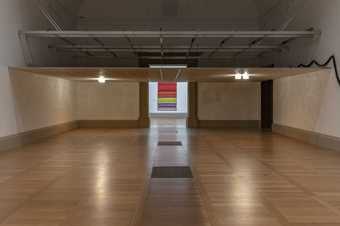
Fig.1
Installation view of the modular ceiling and lamps as part of Ima-Abasi Okon’s display at Tate Britain, London, 2021
© Ima-Abasi Okon. Courtesy the artist
Photo: Seraphina Neville, Tate
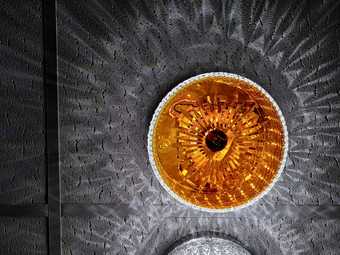
Fig.2
Detail of one of the lamps in the installation at Tate Britain, 2021
© Ima-Abasi Okon. Courtesy the artist
Photo: Tate
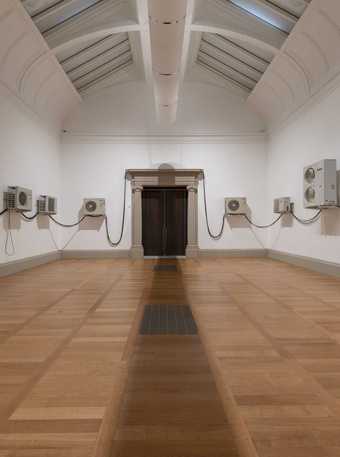
Fig.3
Installation view of the air conditioning units blowing air in time with the audio work as part of Ima-Abasi Okon’s display at Tate Britain, London, 2021
© Ima-Abasi Okon. Courtesy the artist
Photo: Seraphina Neville, Tate
Before continuing, I would like to describe my experience of Okon’s artworks as displayed at Tate Britain. Okon’s works occupied a large, high and bright gallery space with grand architectural features that share common cues with buildings of authority: very tall, dark, stained-wood doors framed by ionic columns, with a ceiling that is partly raked glass, partly curved plasterwork. The overall impression of the gallery space is one of the cohesive design and formal elegance of the late nineteenth century. Utilities such as mains electricity are hidden from view, while the lighting is concealed behind an opaque glass and chrome central feature. Ventilation grilles are discreetly embedded within the immaculate motif of the wooden flooring. Seemingly in contrast with almost every aspect of this, Okon’s work consists of everyday off-white ceiling tiles suspended across half of the space, at a height that interrupts the architecture and slices across the aperture of the doors (fig.1). The ceiling suspension system is visible, a huge void above the tiles occupied by the daringly obvious utilities of aluminium frames and steel wires. Underneath the tiles are mounted two pairs of highly detailed cut crystal light fittings that are part filled with a mysterious golden-brown liquid and cast a warm and sometimes intricate glow around them (fig.2). In the other half of the gallery are eleven evenly spaced air conditioning units of varying make and size, each bearing the dents and scrapes of a life prior to the museum (fig.3). The units are connected to one another with starkly visible bundles of electrical wire that sag and drape under their own weight as they loosely trace the perimeter of the space. The ceiling and fans are mounted just high enough to be out of reach; just high enough that the amount of space below them combines with the unusual expanse of empty floor. In the air conditioning units, the fans spin in varying slowly evolving patterns, sequenced with audio that plays from speakers concealed within them. The sound is musical but is slowed to the point that its rhythm almost ceases to flow, the notes and transients5 stretched to the point of beginning to take on new textures. The soundtrack is accompanied by the whir and occasional rattle of the fans and their housings. At their most active, a gentle breeze can be felt on the cheek.
Using a set of resources – essays, books, interviews and a film – that Okon had compiled for a previous installation of the artworks at the Chisenhale Gallery, London in 2019, the research team sought to ‘learn the artworks’.6 Put simply, we prioritised engaging with the contextual and conceptual material surrounding the artworks over our own processes and timelines. As a team we navigated the learning resources, making connections and reflecting on our practice, positionality and perception gaps. The texts were dense – overwhelming to navigate as a whole, yet as we contemplated them over time and as a team we found ourselves able to catch insights into the world of the artwork. This way of learning was analogous to what would come to unfold in the gallery spaces as we installed the artworks, where we found that our attempts to instantaneously understand the works in their entirety were misplaced. Instead, through the collaboration and reciprocity of the installation period, we were offered ever more meaningful glimpses of the artworks’ world. In trying to understand how we could care for these works we explored questions such as ‘What do the artworks do?’ alongside ‘What are the artworks?’. Guided by the process of learning the artworks, working with Okon became as much a reflexive7 examination of ruliness within the museum, and my place within the drive for ruliness, as it did a study of the unruliness of the artworks themselves. In our desire to have an artwork in perpetuity, and the myriad conservation tasks that this entails, where have we created obstacles to letting the artwork be?
Notes on care
Taking the idea of caring for artworks as a starting point, I experiment in this paper with grouping care in the following five ways: caring and fixing, caring and knowing, caring and communicating, caring and loving, and caring and adapting. First, I explore care’s rootedness in our inherited museum practices of ‘fixing’ and ‘knowing’, and propose these as limiting frameworks that create loss. ‘Caring and fixing’ means that in order to repeatedly display an artwork we inevitably limit some of its parameters or sever it from its network in some way, while ‘caring and knowing’ involves a current model of knowledge-gathering that is hurried, inherently imbalanced, and precludes true collaboration and therefore the richness of reciprocity.
I then frame the third concept of care – ‘caring and communicating’ – as an axis around which our practice of care can evolve away from the inherited practices of fixing and knowing. Caring and communicating represents the idea that the museum’s tools for communication are often limited by technical systems, templates and language, to the extent that we are erasing the non-verbal connections between bodies and things. By making space for experience and multiplicity of voice, we can acknowledge and benefit from a relational approach.
Finally, I arrive at the living, relational groupings of loving and adapting as forms of care. I propose that these approaches facilitate the transformation of care into something that acknowledges and creates space for the dynamism and diversity of life: the lives of the artists, artworks and museum professionals who care for them. ‘Caring and loving’ is based on the notion that related to care is the magical and often hidden mode of personal relating: connecting through, feeling and showing love. I explore how acting with love can guide us by honing a core attentiveness to what is important in our work. Alongside this, ‘caring and adapting’ indicates that our notions of care should be in vital, inevitable flux, informed by evolving artworks and changing socio-economic contexts. We must allow ourselves and our processes to change in response to complex and political artworks.
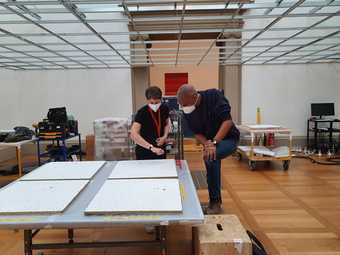
Fig.4
Libby Ireland, Sculpture and Installation Conservator (left), and Mikei Hall, Senior Art Handling Technician (right), discussing the ceiling tiles during the installation of Okon’s work at Tate Britain, 2021
Photo: Tate
In this article I aim to explore the various influences and embedded processes that shape my daily activities and actions, recognising them as ‘apparatus’ as described by philosopher Giorgio Agamben: ‘I shall call an apparatus literally anything that has in some way the capacity to capture, orient, determine, intercept, model, control, or secure the gestures, behaviors, opinions, or discourses of living beings.’8 I consider the museum as an apparatus with complex and hierarchical layers of process that can co-opt and inform my notions of care. I reflect on the influence of different types of apparatus: human, relational modes of engagement and discovery that enabled a synchronisation with the slowly unfolding temporalities of Okon’s artworks and practice. I conclude that by teasing at the boundaries of our collecting and care strategies, Okon’s ‘unruly’ artworks contribute subtle shifts in practice that are in company with changes brought about by other unruly works. These artworks require us to meet them on their terms; they highlight the constraints of our set processes and require us to think anew each time we engage with them (fig.4).
I wish to acknowledge the complexity of the word ‘care’ and its associated actions: that its meaning and labour can be easily monetised, co-opted and steered towards the interests of the museum over those of the individual, artist or artwork. While the museum’s appetite for care is infinite, our capacity to sustain it at an institutional and personal level is, of course, limited.9 I acknowledge that the time, support and resources afforded by the Reshaping the Collectible project allowed me to explore a way of working that I would not have been able to under normal circumstances, so while I might advocate for an emotional attachment to caring for artworks, this simply would not be sustainable for an individual under our normal operating model.10 To show sustainable, commensurate levels of care to complex artworks therefore requires change on a level beyond that of the individual – it requires institutional and structural acknowledgement through a slowing of workload or an increase in resources. Without this, there is the very present danger that what Domínguez Rubio calls the ‘contours of our neglect’ exclude not only other elements of our workload, but our quality of life as humans.11
I am also conscious that in my exploration of care, I am focused on the relationship between artist, artwork and members of the conservation team. There are many roles and departments within the museum that represent and negotiate care in dialogue with the artist and the museum visitor (for example, Health and Safety, Visitor Experience, Learning and Interpretation), and this is a key point in Huberman’s essay.12 While I am hopeful that the voices of visitors might be acknowledged and represented in conservation decision-making in the future, this paper reflects on the current practice of the conservator, where decisions on the present and future needs of the work are taken without visitor dialogue.
Much of this work was undertaken throughout the first year of the COVID-19 pandemic, a time when what it means to ‘care’ on a personal or systemic level felt subject to an audit at almost every turn. It was also a time during which, without the anchors or distractions of daily routine, we could imagine exiting the pandemic to a renewed landscape where neglect might not be so prevalent. This, combined with the jumping-off point of ‘caring’ for artworks, led me to choose care as a central theme. I offer the following sections not as arguments or conclusions, but rather as something that exists between diary, imagination and reflexive practice on the daily reality of my role as a conservator. This is perhaps best described using sociologist Michael Halewood’s notion of ‘speculation’ as situated in practice and as distinct from the open, freeform jump of ‘imagination’: ‘[I]n jumping, we must not imagine that we have freed ourselves from the world in which we are situated. The jump does not come from nowhere. We jump from a specific place, a specific ground.’13
Reflections on writing
The process of writing this paper has been one of synchronous journeys. Of most outward significance is the gradual shift in conservation approach that was a result of embedded research, which consisted of reading, learning and collaborating. In parallel, I was learning what my role would be as a novice embedded researcher within a deeply experienced team. While I have some years’ experience as a time-based media conservator, my background is in music and audio/electrical engineering and therefore I have tended to work on artworks that are complex due to their engineering scale or technical detail. For these artworks, written outputs aim to be concise, precise and definitive. Within the Reshaping the Collectible research project, of which this paper forms part of the output, the complexity of the artworks studied lay in the way in which these works related to things, people and the inherited processes of the museum. For the first time I was invited to write with an open remit. Being freed from precision was at first an agonising barrier, the ephemeral and relational qualities of the experience seemingly unsuited to being coerced into text. Yet throughout writing, the process became gradually nurturing as I learned to work alongside the constraints and towards the possibilities of writing as a tool for journeying and exploration. In doing so, I have been deeply fortunate to have the support of an incredible team of researchers and editors at Tate, without whom I would have definitely floundered.
There was one common theme in the editorial feedback I was given: that I should introduce, clarify and conclude my paper clearly, to be generous to its readers and to strengthen my argument. In response I felt a need to protect a quality of the journey that I had undergone with Okon’s artworks, where I observed that we are hooked on instantaneous knowledge transfer, and that if a writer, researcher, artist or practitioner cannot fully impart their experience without opacity, they could be considered to be ungenerous.14 I was also curious about published writing and its tendency towards arguments. I could not escape the feeling that an argument is something that occurs when people are unable to accept that another experience may differ from their own. As I will go on to explain, Okon’s practice and artworks are partly a response to, and reactive to, the museum system in which they are supported, and I will show how this triggered reflexivity in me – not only around museum practices but also in response to the processes that shape written outputs.
One other consistent bit of advice I was given is that thinking about who my writing is for would help me. It did help, but instead of clarifying my arguments, it made me think of my colleagues and professional acquaintances across the globe whom I have witnessed having an emotional or reflexive entanglement with their work when seeking change in the museum, and who might have relayed something incomplete, imperfect, heartfelt or vulnerable in their attempt to transform, journey or transcend. It also made me think of the impossible task of the completeness of arguments as a barrier: that it only takes a tiny bit of these colleagues’ experience to chime with mine to create that magical feeling of change being possible. Rather than putting forward an argument, perhaps describing experience is a worthy enough contribution.
Caring and fixing
As a result of the desire to efficiently collect and display artworks, museum practices have been shaped by the ideologies of complete ownership, complete knowing and artwork fixity. By owning and understanding a stable artwork with limited parameters of change, the museum can confidently repeat the display of an artwork with a degree of sameness. Okon disrupts the idea of complete ownership by creating what she has described as an ‘unlimited edition’, a distributed model in which Tate owns limited elements of the work, while further elements can exist and be shown alongside Tate’s, as well as being added to or borrowed from at will. The artist also disrupts the idea of complete knowledge by creating external dependencies – nominated networks of specialists who interpret elements of the work for a new environment. Her work resists fixing through the artist’s involvement in future processes: Okon responds bodily to new installation spaces, and personally undertakes specific practices related to reproducible aspects of the artwork.
Fixing and sameness ultimately allow the artwork to fit a description. Upon entering the museum, an artwork will be described many times and by many different people, including, but not limited to: the acquiring curator in the text of a Trustees’ Note when it is being put forward for acquisition; the registrars entering details about its medium, duration and dimensions on a collections management database; and the conservator at the ‘pre-acquisition’ stage who is tasked with estimating how expensive, how time-consuming, and how difficult to pin-down it might be in order to fit it within a matrix of cost and time described as ‘simple, medium or complex’. It will go on to be described in great technical detail by the conservator in the ‘display specification’, will be discussed historically and conceptually by curators, researchers and interpretation editors on captions and wall texts during its display, and on the ‘Art and Artists’ section of the Tate website.
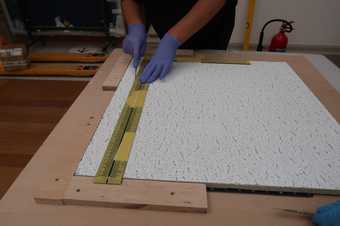
Fig.5
Art Handling Technician, Lily Crew, cutting one of the artwork’s ceiling tiles during installation, Tate Britain, 2021
Photo: Libby Ireland, Tate
Ultimately, the description of the artwork situates it within the museum collection and grants the museum the ability to present information about it to the public. Reading Tate’s mission statement, which is ‘to increase the public’s enjoyment and understanding of British art from the sixteenth century to the present day and of international modern and contemporary art’, we can see how necessary it is for the museum to understand the object, and for the object to remain the same in order to repeatedly impart this understanding.15 Both through her ongoing involvement with works after they are collected, and by stating that the works can exist in different forms across different owners, Okon accepts various changes and adaptations in her installations. These include diminishment (for example, the number of ceiling tiles is reduced as they are altered through installation; fig.5), augmentation (such as when the work is displayed with different audio), and dynamic responses to the diverse spaces in which they are shown. In so doing, Okon accepts these changes as fundamental to the life-breath or ‘pneuma’ of the work.16 This resists the fixing of the work and highlights what Huberman describes as the underlying problem with displaying a static object: ‘Much of the difficulty with making an exhibition lies in the fact that to extract something from circulation – an object, image, practice, or idea – and interrupt it, examine it, and exhibit it, is to do it a great injustice.’17
Okon also resists the museum’s ideology of complete knowledge of an object by creating external dependencies: she delegates installation tasks to networks outside the museum, such as giving her sound engineer and collaborator Jack James keywords to respond to when sequencing the fans and audio. This makes space for, and empowers, interpretations outside those of the museum. The desire for a journeying, more fluid interpretation is also reflected in the artwork titles. Often long, they have an interrupting grammar that might give the viewer similar prompts and empowerment for further interpretation. This can be seen in four of the titles of the works held by Tate:
When the —[After-the-world presocial vivid thereness and ongoingly] — is in the system 2019
When the —[After-the-world presocial vivid therenessss and ongoinglyy] — is in the system 2019
The final title listed here hints in particular at some of the qualities of Okon’s works that we would come to experience during their acquisition and installation: that it is on the move, dynamic; that in pneuma, it has a breathing or living quality; and that in extra subjectivity is the layer of relationality and collaboration that we encountered during its unfolding.
Dated 2019–21, the fifth artwork owned by Tate has a very long title, as it itemises all of the ceiling tiles that make up the work, and this title will continue to grow as Okon adds more tiles to the work in future:
M – C – M(1 with Peace, 2 without Peace, 3 with Peace, 4 without Peace, 5 with Peace, 6 without Peace, 7 with Peace, 8 without Peace, 9 with Peace, 10 without Peace, 11 with Peace, 12 without Peace, 13 with Peace, 14 without Peace, 15 with Peace, 16 without Peace, 17 with Peace, 18 without Peace, 19 with Peace, 20 without Peace, 21 with Peace, 22 without Peace, 23 with Peace, 24 without Peace, 25 with Peace, 26 without Peace, 27 with Peace, 28 without Peace, 29 with Peace, 30 without Peace, 31 with Peace, 32 without Peace, 33 with Peace, 34 without Peace, 35 with Peace, 36 without Peace, 37 with Peace, 38 without Peace, 39 with Peace, 40 without Peace, 41 with Peace, 42 without Peace, 43 with Peace, 44 without Peace, 45 with Peace, 46 without Peace, 47 with Peace, 48 without Peace, 49 with Peace, 50 without Peace, 51 with Peace, 52 without Peace, 53 with Peace, 54 without Peace, 55 with Peace, 56 without Peace, 57 with Peace, 58 without Peace, 59 with Peace, 60 without Peace, 61 with Peace, 62 without Peace, 63 with Peace, 64 without Peace, 65 with Peace, 66 without Peace, 67 with Peace, 68 without Peace, 69 with Peace, 70 without Peace, 71 with Peace, 72 without Peace, 73 with Peace, 74 without Peace, 75 with Peace, 76 without Peace, 77 with Peace, 78 without Peace, 79 with Peace, 80 without Peace, 81 with Peace, 82 without Peace, 83 with Peace, 84 without Peace, 85 with Peace, 86 without Peace, 87 with Peace, 88 without Peace, 89 with Peace, 90 without Peace, 91 with Peace, 92 without Peace, 93 with Peace, 94 without Peace, 95 with Peace, 96 without Peace, 97 with Peace, 98 without Peace, 99 with Peace, 100 without Peace, 101 with Peace, 102 without Peace, 103 with Peace, 104 without Peace, 105 with Peace, 106 without Peace, 107 with Peace, 108 without Peace, 109 with Peace, 110 without Peace, 111 with Peace, 112 without Peace, 113 with Peace,114 without Peace, 115 with Peace, 116 without Peace, 117 with Peace, 118 without Peace, 119 with Peace, 120 without Peace, 121 with Peace, 122 without Peace, 123 with Peace, 124 without Peace, 125 with Peace, 126 without Peace, 127 with Peace, 128 without Peace, 129 with Peace, 130 without Peace, 131 with Peace, 132 without Peace, 133 with Peace, 134 without Peace, 135 with Peace, 136 without Peace, 137 with Peace, 138 without Peace, 139 with Peace, 140 without Peace, 141 with Peace, 142 without Peace, 143 with Peace, 144 without Peace, 145 with Peace, 146 without Peace, 147 with Peace, 148 without Peace, 149 with Peace, 150 without Peace, 151 with Peace, 152 without Peace, 153 with Peace, 154 without Peace, 155 with Peace, 156 without Peace, 157 with Peace, 158 without Peace, 159 with Peace, 160 without Peace, 161 with Peace, 162 without Peace, 163 with Peace, 164 without Peace, 165 with Peace, 166 without Peace, 167 with Peace, 168 without Peace, 169 with Peace, 170 without Peace, 171 with Peace, 172 without Peace, 173 with Peace, 174 without Peace, 175 with Peace, 176 without Peace, 177 with Peace, 178 without Peace, 179 with Peace, 180 without Peace, 181 with Peace, 182 without Peace, 183 with Peace, 184 without Peace, 185 with Peace, 186 without Peace, 187 with Peace, 188 without Peace, 189 with Peace, 190 without Peace, 191 with Peace, 192 without Peace, 193 with Peace, 194 without Peace, 195 with Peace, 196 without Peace, 197 with Peace, 198 without Peace, 199 with Peace, 200 without Peace, 201 with Peace, 202 without Peace, 203 with Peace, 204 without Peace, 205 with Peace, 206 without Peace, 207 with Peace, 208 without Peace, 209 with Peace, 210 without Peace, 211 with Peace, 212 without Peace, 213 with Peace, 214 without Peace, 215 with Peace, 216 without Peace, 217 with Peace, 218 without Peace, 219 with Peace, 220 without Peace, 221 with Peace, 222 without Peace, 223 with Peace, 224 without Peace, 225 with Peace, 226 without Peace, 227 with Peace, 228 without Peace, 229 with Peace, 230 without Peace, 231 with Peace 232 without Peace, 233 with Peace, 234 without Peace, 235 with Peace, 236 without Peace, 237 with Peace, 238 without Peace, 239 with Peace, 240 without Peace, 241 with Peace, 242 without Peace, 243 with Peace, 244 without Peace, 245 with Peace, 246 without Peace, 247 with Peace, 248 without Peace, 249 with Peace, 250 without Peace, 251 with Peace, 252 without Peace, 253 with Peace, 254 without Peace, 255 with Peace, 256 without Peace, 257 with Peace, 258 without Peace, 259 with Peace, 260 without Peace, 261 with Peace, 262 without Peace, 263 with Peace, 264 without Peace, 265 with Peace, 266 without Peace, 267 with Peace, 268 without Peace, 269 with Peace, 270 without Peace, 271 with Peace, 272 without Peace, 273 with Peace, 274 without Peace, 275 with Peace, 276 without Peace, 277 with Peace, 278, without Peace 279 with Peace, 280 without Peace, 281 with Peace, 282 without Peace, 283 with Peace, 284 without Peace, 285 with Peace, 286 without Peace, 287 with Peace, 288 without Peace, 289 with Peace, 290 without Peace, 291 with Peace, 292 without Peace, 293 with Peace, 294 without Peace, 295 with Peace, 296 without Peace, 297 with Peace, 298 without Peace, 299 with Peace, 300 without Peace, 301 with Peace, 302 without Peace, 303 with Peace, 304 without Peace, 305 with Peace, 306 without Peace, 307 with Peace, 308 without Peace, 309 with Peace, 310 without Peace, 311 with Peace, 312 without Peace, 313 with Peace, 314 without Peace, 315 with Peace, 316 without Peace, 317 with Peace, 318 without Peace, 319 with Peace, 320 without Peace, 321 with Peace, 322 without Peace, 323 with Peace, 324 without Peace, 325 with Peace, 326 without Peace, 327 with Peace, 328 without Peace, 329 with Peace, 330 without Peace, 331 with Peace, 332 without Peace, 333 with Peace, 334 without Peace, 335 with Peace, 336 without Peace, 337 with Peace, 338 without Peace, 339 with Peace, 340 without Peace, 341 with Peace, 342 without Peace, 343 with Peace, 344 without Peace, 345 with Peace, 346 without Peace, 347 with Peace, 348 without Peace, 349 with Peace, 350 without Peace, 351 with Peace, 352 without Peace, 353 with Peace, 354 without Peace, 355 with Peace, 356 without Peace, 357 with Peace, 358 without Peace, 359 with Peace, 360 without Peace, 361 with Peace, 362 without Peace, 363 with Peace, 364 without Peace, 365 without Peace, 366 without Peace, 367 without Peace, 368 without Peace, 369 without Peace, 370 without Peace, 371 without Peace, 372 without Peace, 373 without Peace, 374 without Peace, 375 without Peace, 376 without Peace, 377 without Peace, 378, without Peace 379 without Peace, 380 without Peace, 381 without Peace, 382 without Peace, 383 without Peace, 384 without Peace, 385 without Peace, 386 without Peace, 387 without Peace, 388 without Peace, 389 without Peace, 390 without Peace, 391 without Peace, 392 without Peace, 393 without Peace, 394 without Peace, 395 without Peace, 396 without Peace, 397 without Peace, 398 without Peace, 399 without Peace, 400 without Peace, 401 without Peace, 402 without Peace, 403 without Peace, 404 without Peace, 405 without Peace, 406 without Peace, 407 without Peace, 408 without Peace, 409 without Peace, 410 without Peace, 411 without Peace, 412 without Peace, 413 without Peace, 414 without Peace, 415 without Peace, 416 without Peace, 417 without Peace, 418 without Peace, 419 without Peace, 420 without Peace, 421 without Peace, 422 without Peace, 423 without Peace, 424 without Peace, 425 without Peace, 426 without Peace, 427 without Peace, 428 without Peace, 429 without Peace, 430 without Peace, 431 without Peace, 432 without Peace, 433 without Peace, 434 without Peace, 435 without Peace, 436 without Peace, 437 without Peace, 438 without Peace, 439 without Peace, 440 without Peace, 441 without Peace, 442 without Peace, 443 without Peace, 444 without Peace, 445 without Peace, 446 without Peace, 447 without Peace, 448 without Peace, 449 without Peace, 450 without Peace, 451 without Peace, 452 without Peace, 453 without Peace, 454 without Peace, 455 without Peace, 456 without Peace, 457 without Peace, 458 without Peace, 459 without Peace, 460 without Peace, 461 without Peace, 462 without Peace, 463 without Peace, 464 without Peace, 465 without Peace, 466 without Peace, 467 without Peace)
Throughout each of the practices described above, Okon highlights a tension at the heart of time-based media conservation: as conservators we often enter understandings with artists that we will work tirelessly towards maintaining sameness in artworks – promising that the key properties of a video file will never change, that the playback equipment will remain consistent, that the room dimensions will be within acceptable parameters. Yet we hold the knowledge that the pressure against sameness will be ongoing and dynamic in character, as inexorable equipment revisions mesh with uncharted display spaces. Conversely, when encountering a work that asks for a potentially limitless flexibility, it feels that all we can do is imagine future scenarios, envisioning budget constraints and display timelines, leading us to shortcut the unknown future forms of an artwork into limited permutations, and from there into multiple choice.
Let me illustrate this with an example from the acquisition process for Okon’s artworks: we acquired eleven fans, but the number and position can vary in response to the display space. Some of the fan units contain speakers that play a soundtrack controlled by a Logic session – this also controls the rotational speed of the fans via midi-DMX.18 This is controlled by a ‘score’ which is modified in response to the installation configuration by Jack James, the sound engineer and audio practitioner with whom Okon had worked on some of the technical aspects of the piece’s creation. To unpick the parameters of variability within this aspect of the work, we suggested a test installation at Tate Store in January 2021, ahead of the installation in March/April 2021. We sought some suggested configurations of the fans and speakers so that we could learn how the speakers and score might be adapted to different room sizes, layouts and acoustics. It felt as though each time we offered a potential ‘type’ of layout for a typical gallery space, Okon suggested a million possible other configurations that we had not considered. The feeling was that our chance to understand the work was escaping us – a feeling explained by the hidden pressure of needing to know, for our documentation and for future displays. We had the feeling that the confidence of future curators and conservators was dependent on our ability to gather this information, and that opportunities to garner this knowledge were time limited. Through proposing fixed scenarios, we hoped to unearth an underlying, repeatable logic.
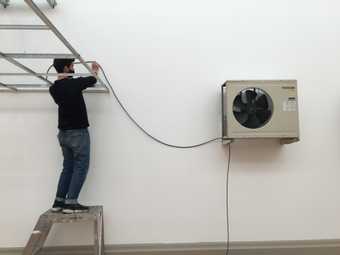
Fig.6
George Morris, Senior Time-Based Media Conservation Technician, installing the air conditioning units, Tate Britain, 2021
Photo: Tate
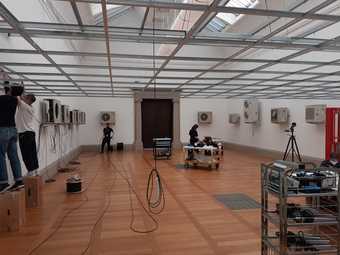
Fig.7
A view of the art handlers, conservators, conservation technicians and contractors installing Okon’s work, Tate Britain, 2021
Photo: Tate
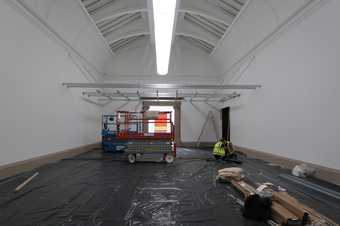
Fig.8
Contractors installing the metal frame for the ceiling element of the display, Tate Britain, 2021
Photo: Tate
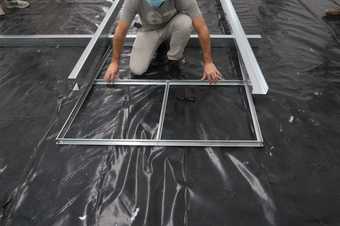
Fig.9
A contractor installing the metal frame for the ceiling element of the work, Tate Britain, 2021
Photo: Tate
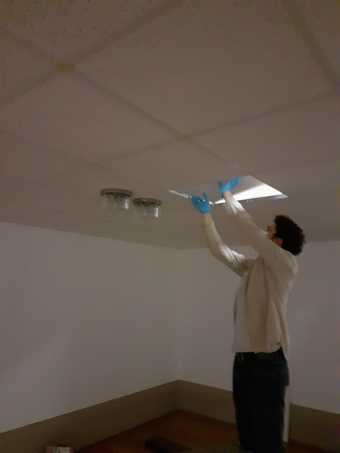
Fig.10
Art handler Andre Figueiredo Silva installing the final tile in the ceiling element of the work, Tate Britain, 2021
Photo: Tate
Because of rising pandemic cases, we were not able to experiment with the test scenario, but on reflection, the process of spending time during installation learning about Okon’s relationship to the work provided a more fruitful point from which to unpack the relationship of the work to the space. There are traces of logic to her process that we can carry onwards, but they are traces unique to Okon’s practice and hence it took the time to install, collaborate and learn to slowly discover them. This is an example of how accustomed we conservators are to leading with suggestions: in discussing the test, we were essentially saying ‘we think we have understood your logic and now we propose X, Y or Z’. These suggestions were not picked up by Okon and while that in itself is not particularly unusual, what did feel unusual was that it did not feel like Okon stepped forward into the role of leading either. The conservation team noted this as a kind of vacuum. Working in the gallery, I noticed the character of how Okon made decisions: spending time with objects and the space, striking a balance between order and chance – for instance, not wanting to interfere too much with the way the cables were run by the electrical team, letting the cables hang naturally (figs.6 and 7), or leaving the way that ceiling tiles were hung to contractors (figs.8–10). There was a balance, fluidity and presence to decision making in the space that came to fill the vacuum that we had noted in our previous meetings.
This validated a previous request that Okon had made: that our interviews with her not be recorded. Upon first hearing the request it was understandable – Domínguez Rubio describes how artist interviews are carried out from a museum’s perspective, eliciting initial responses sometimes of an exploratory nature that then become subject to museum interpretation, all the while seeking to reinforce the beliefs of the museum:
Interviews are, and can only be, technologies of provocation. They never merely ‘retrieve’ or ‘elicit’ a subject that is already out there waiting to be disclosed; they work by provoking a subject into being. Further, the subject provoked is not just any kind of subject: it is a very specific type of subject, the storied and self-reflexive self.19
I later came to realise that Okon’s refusal of recordings created space: space for the true, non-museum story, and the space that Okon needed to learn of our processes, to collaboratively understand and shape the support and care that the work requires. Here, there was alchemy, a process that transcended the framework of the interview, and a reciprocity in approaching these questions from a mutual standpoint of learning and discovery.
My central concern as a conservator of Okon’s works, and works like them, is that by absorbing the culture of knowing and fixing we are narrowing our opportunities to learn, creating loss through missed reciprocity. Huberman, in writing about displaying works, talks of a shifting landscape from knowing to caring, an environment in which all perspectives on an artwork are shared: ‘It’s not about preparing explanations in advance, but about following the life of an idea, in public, with others.’20 How could the conservation of works mirror this approach? How could our documentation be decoupled from control and reflect the unfolding of our mutual learning? Okon’s artworks evolve and adapt, not just in our care but across distributed ownership. In this instance, our embedded approaches to fixing sit uneasily with letting the artwork live. This highlights a potential divergence in conservation ethics as imagined by the artist Henry Bradley, who has reflected on the potential for ‘A conservation as a “practice” for artworks, rather than “in service” to the museum. A conservation more inherently tied to the politics of the artwork than the museum.’21
Caring and knowing
The harder it is to fix an artwork, the harder it is to know it, and the harder Tate’s mission of imparting understanding about the work becomes. Looking around the contemporary museum, we see the culture of fixing and prepared explanations manifesting in wall texts and discourse such as exhibition catalogues. Often brief, formal and of anonymous authorship and undisclosed positionality, the museum’s interpretation material is awarded a god-like status of indisputable authority, leaving little space for alternative experience and interpretation. In a keynote lecture on inviting new voices into museums, the museologist James M. Bradburne highlights this inherent hierarchy in the presentation of information: ‘Over the past decades, the museum has increased its emphasis on narrative coherence and storytelling. The stories told, however, are largely determined by museum professionals. This means that although the stories may change, the underlying “power structure” – from expert to lay person – remains unchanged and unchallenged.’22
In a paper on her curatorial approach to the exhibition Typecast: Flinders Petrie and Francis Galton at Petrie Museum of Egyptian Archaeology, London in 2011, curator Debbie Challis has discussed the problematic nature of the museum’s hierarchical presentation of knowledge when working on the highly sensitive subjects of race, identity, heredity and eugenics.23 In particular, Challis emphasised her need to counter the supposedly neutral, authoritative voice of the museum and state her own positionality in the interpretation for the exhibition. She did so by reflecting on this in the introductory wall text: ‘Museum displays rarely give the identity of the curator, but speak in a third person voice to be more “objective” and “neutral”. But, who I am informs this exhibition. I have written the displays in the traditional “neutral” and “objective” third person voice ... Does this exhibition show my own, unconscious, assumptions about identity?’24 Challis argues that the belief that an institution can be neutral is a falsehood, using the example of the BBC and its attempts to provide neutral, balanced coverage while a historical perspective on its archives belies a different story. As Challis observes: ‘However much an institution presents itself as neutral and aims to be balanced, its own history often provides evidence to the contrary, particularly when describing emotive areas in history and conflict.’25
This presentation of knowledge is something of which Tate’s Interpretation department is acutely aware. Hannah Geddes, a curator of interpretation at Tate, describes having to work towards a complex balance with every artwork – a balance between taking care of the visitor by making information easily accessible and taking care of the artist by making them feel properly represented and safe in the presentation of knowledge about their work, all while being aware of the perspective of the curators at Tate in combination with the institution’s processes and decisions. Geddes reinforces the idea of forwarding positionality, stating that ‘positionality is key and something that is so important in revealing the hidden processes of the institution (we are moving towards authoring more texts in gallery and trying to have exhibition positionality statements). But we always have to ask ourselves what our positionality is in relation to – what and who (visitor/artist/institution)?’26 Similar to Huberman’s sentiments, Geddes states that making this complexity visible is fundamental to welcoming the visitors’ views and engagements with the life of an idea, and emphasises the importance of a ‘learning the artwork’ perspective for each work: ‘Set processes always fail, we need to respond to each conversation as it happens’.27 It is interesting to note how Okon’s own practice influenced the balance that Geddes talks of: since Okon considers the presentation of the artwork titles to be part of the work, she wanted autonomy over the text in the gallery space, choosing the typeface and type size. This unsettles the inherent hierarchy in the presentation of knowledge about the object from the museum’s ‘neutral’ and authoritative voice by forwarding the artist’s voice and positionality. However, Geddes states that by viewing artwork captions as part of the artwork itself, the balance was perhaps tipped away from taking care of the visitor. For example, the small font size and typeface chosen by Okon, in combination with the low lighting required in the installation, did not foreground accessibility for visitors in the space.
During this process I became interested in tracing a line back from a neutral and authoritative presentation of knowledge, trying to understand how it might exist as an invisible culture that pervades museum practice, and how acting on its behalf might have influenced my approach to conserving artworks. Through day-to-day interactions, I started to notice how the museum’s unattainable and hidden desire for certainty characterised the things that people asked of me on a daily basis. Some of these interactions require an imminent response with tangible outcomes, such as providing the cost of a suitable projector to a curator so that they can budget for an artwork display, or deciding what the minimum size of a room could be according to an artwork specification so that an installation manager can instruct a team of contractors to build the walls. Others were longer term, with vaguer boundaries, such as management asking: ‘Can you finish your work on acquiring this unruly artwork by August, please?’. These daily interactions were all different in character, all required me to juggle technical, conceptual, aesthetic, budget and resourcing variables, and all ultimately have one theme in common: they require me to deliver knowing with certainty. It can feel like a standard that is hard to measure up to, and it does not always feel like the option of saying ‘I don’t know’ exists. These questions asked of the conservator by their daily professional networks among a busy workload create an inclination towards efficient, definitive answers largely out of self-preservation. Thus, an internalised desire towards establishing a permanent and stable final form for an artwork has been created that meets the museum’s thirst for knowing. The pressure on the individual has felt especially pertinent during the COVID-19 pandemic: hundreds of museum staff have been lost through redundancy and budgets have been cut with promise of a proportional decrease in workload.28 Yet in fact the opposite is true – for example, in the time-based media exhibition and displays team, a normal financial year would consist of around eighty ‘actions’ consisting of installations or deinstallations. At the time of writing, in the final month of the financial year 2021–2, there have been 102 actions and counting.
During the process of acquiring and installing Okon’s five works, I started to notice a fundamental thread: knowing requires few words, whereas not knowing requires discourse. Since the museum’s voice can only speak in terms of knowing, not knowing invites the voices of one or more individuals to contribute their opinion. Holding uncertainty among a busy schedule of meetings can feel confusing and anxiety-inducing. Deviating from an authoritative voice starts to feel like what Huberman describes as ‘the vulnerable, dangerous, and radical act of wearing their heart on their sleeve’.29 Furthermore, he suggests stepping outside of the knowing/not knowing binary and ‘performing both the I Know and the I Don’t Know in the key of I Care.’30 Unpacking this further, he describes this as a shift in our mode of engaging with ideas:
If an institution goes from knowing to caring, it could point to the affective relationship that ties people to ideas and become a place for attachment rather than consumption. After all, the ideas that make us curious are not the ones we fully understand, but the ones we care about – I Love It is always more compelling than I Get It.31
As we stepped away from the role of knowing Okon’s works, the mode of engagement that Huberman describes started to surface. I noticed a subtle shift in the character of meetings: under normal circumstances they can feel hierarchical, structured. I might be expected to arrive prepared to deliver knowledge at a time that fits within the meeting schedule in accordance with a prepared agenda. In this way we function insidiously as subsidiaries to the museum’s presentation of knowledge. Instead, answering a question such as ‘How should we schedule the installation?’ with an openness to not knowing broke down the hierarchical barriers of the meeting and invited animated input and opinion about the artworks and their interpretation from a broad range of staff, regardless of role. Furthermore, I was relieved of the pressure of the unattainable standard of knowing! The involvement that was invited through the need for discourse and engagement echoes with what Huberman describes as ways of working that are more affective than effective: allowing for an attachment to museum life through unfurling curiosity, discovery and positionality, in counterpoint to the pressure created by the museum’s restless drive for efficient, complete and neutral knowledge.
Caring and communicating
While Okon’s works might challenge broad notions of knowing and fixing, they also pointedly draw attention to our use of language and its role in those processes. In her artwork titles Okon freely uses duplication of words and irregular punctuation to intervene in the relatively automatic process of reading. She does this in order to make visitors ‘tarry’,32 and to encourage them to create an attachment to the artwork through spending time with the titles. It is interesting to note that the use of duplication in the title of one of Okon’s works pushes it beyond the character limit of Tate’s object records system, highlighting the limiting factor of language in our records management system – a system already inherently geared towards fixing artworks. Another instance of Okon reframing relationships with the museum while creating space for interpretation through her use of language is in a contract that she drew up with the Showroom Gallery in 2018. In it, she reimagined what the relationship between institution and artist might be through her definition of ‘support’, which included the phrase ‘unconditional love’.33 Yet she has also pointed to the shortcomings of ‘love’ as a word:
For me, there will always be a dissonance between the feeling I have ... and through the apparatus that I’ve been given to communicate that to you, there’s always going to be some fallout ... My love for lamb is completely different to my love for [the singer] Mahalia Jackson, completely different to my love for your dogs in this place, but I’ve just been forced to use this one word.34
Despite the ambiguity of such words, I hope that by approaching the formation of a supporting relationship of care through reciprocity in the acquisition and display of these works, and by stepping back from knowledge, we get closer to fulfilling the feeling behind the contract conditions rather than hanging on the words. Expanding on the meaning of unconditional love, we can begin to imagine what such a contract would ask of us: to actively seek the very best for the work, to welcome its changing form, and to be able to rise above our own context and conditions in order to display it? Is it asking us to do this through no benefit to ourselves, but for the sake of the work itself? What would a museum organised around this idea look like?
A theme that recurred through interviews with Okon was her interest in objects behaving as themselves, embracing their natural entropy or the interactions that might occur between them when left to their own devices, thus decentering humans as the agents of change. During installation Okon also spoke of the need to feel the space and the objects with her body in order to make decisions about the display of the work. Acknowledging the effects that objects can have on humans is something that philosopher Jane Bennett explores in her description of the interactions that take place between humans and art objects: ‘Could we not understand the encounter with them more horizontally as, that is, engagements between bodies, some human and some not, each of which would re-form the others and be re-formed as a result of the exposure? What effects might these items produce or induce as we meet them directly (in space) or indirectly (as description)?’35 Considering that Okon wishes to keep these horizontal engagements between human and non-human bodies present in her installation practice, and using this to reflect on our early interviews with Okon, I can see how our objective style of questioning during those sessions was an especially blunt tool. I recognise that our attempts to elicit responses to suit the written form of documents is in some way the metric of success in our jobs as conservators. As Domínguez Rubio states, interviews may have the effect of forcing a translation away from something that Okon wants to stay with: ‘[Interviews] force the artist to translate something that usually takes place in the order of bodies, things, and practices into the order of language, that is, into the order of explanations, descriptions, and justifications.’36
It is interesting that the outward aim of the museum is to create emotional and intellectual engagements with artwork for the viewing public, and yet we have seen how central bodily engagements are to Okon’s process. As conservators of her work we experienced the richness of an underlying collaborative relationship in understanding the lively aspects of a work in the museum, and yet conservation documents can seem apathetic in comparison. Designed to compensate for the inevitable severing of the tie between artist and artwork – through the mortality of the artist or the career span of a museum professional – the process of acquiring the work leads to a process of distillation by means of forms and templates, the goal being the creation of a single, authoritative document: the ‘display specification’. This document is written by the conservator from a template and is populated with information gathered from artists’ instructions, interviews and written questions, subject to streamlining and interpretation by the author. Its goal is to communicate a brief to future conservators, efficiently passing on instructions.
How could the display specification more accurately reflect the relationships that support the unfolding of an artwork? Another artwork that was extensively researched as part of the Reshaping the Collectible project is Tony Conrad’s Ten Years Alive on the Infinite Plain 1972 (hereafter Ten Years Alive), a work that comes to life through collaborative interpretation and performance. As with Okon’s artworks, Ten Years Alive was awarded extra institutional time and resources through the Reshaping the Collectible project. The conservation output was some amazing overflowing, ballooning documents full of differing opinion, multiplicity of voice that revealed complex relationships, and several potential strands of interpretation.37 The richness of the resulting documentation and the multiple truths and engagements it represents is in stark contrast to the singular, pared-back, authoritative truth we often encounter through display specifications and catalogue data.
Domínguez Rubio makes the point that not only do objects create engagement on an individual level, but their behaviour creates change on a museum procedural level. Noting how museum processes have been moulded around the traditional, ‘docile’ oil painting,38 he prompts us to think about how complex, unruly artworks could create institutional change: ‘unruly objects can be described as vectors of institutional and cultural change: as elements that require creative adaptations and negotiations, and the shifting of positions and boundaries around them … Or, put differently, my claim is that artworks organize museums as much as museums organize artworks.’39 A rare acknowledgement of this within museum practice is that of couriers or loans conservators repeatedly touring with a work to provide insight on the installation process beyond what is recorded in its display documentation. Somehow, the artwork has pushed beyond the limit of its documentation and asked of the museum an extra apparatus: a human emissary who can hold an understanding of the artist, the artwork, the display and its unfolding story, beyond the limits of its documentation framework. This is at the discretion of the loans conservator, and usually takes place when they deem that an artwork is too complex, that there are too many variables in an installation, or that the presence of an artist or artist’s estate might provide some previously unknown insight. It would be the loans conservator’s responsibility to interpret anything that the display specification might not cover, and modify that document in response. Here the idea of the artwork being ‘alive’ is creeping in: the idea that each display brings the opportunity to get to know it a little better, that it might react in some unknown way to a new set of circumstances.
Turning back to the example of Conrad’s Ten Years Alive, it is interesting to think about this in comparison to the research into Okon’s work. At the heart of the Conrad research was a desire to recognise and acknowledge an existing network of practitioners – such as musicians and projectionists – as holders of knowledge about the performance, especially given that the artist had died in 2016, just before the work began to undergo Tate’s acquisitions process. This meant that the conservator, who is traditionally accustomed to inheriting a degree of authority about an artwork from the artist, instead had to consider what it meant to step into an existing dynamic social network – a network that had already been involved in the care of the artwork for nearly fifty years – and consider the implications and shift in dynamics that this might bring.40 This could be considered an inversion of the usual focus of an artwork entering a museum, where we inherit knowledge from the ‘lone artist’ and create a network of care in response. Similar to our experience with Okon’s work, with Ten Years Alive the process of ceding control, knowledge and authority was complex and highly relational. Group rehearsals, feedback discussions, and one-on-one sessions between previous performers and new ones resulted in the creation of a whole ‘dossier’ of information, with different authors’ voices intact and layers of annotations added on top. In place of pared-back authority was the richness, diversity and multiplicity of a group of non-institutional emissaries that expanded beyond the limits of the gallery and whose varied voices challenged our standard documentation templates.
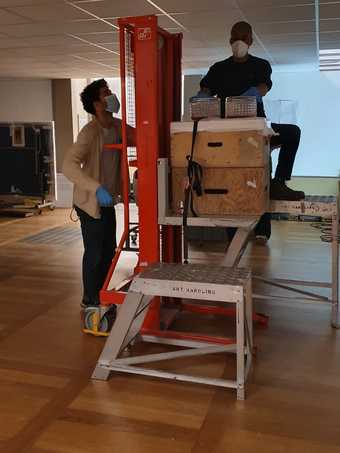
Fig.11
Figueiredo Silva (left) and Hall (right) preparing to install the lamps on the ceiling, Tate Britain, 2021
Photo: Tate

Fig.12
Lily Crew installing the lamps on the ceiling, Tate Britain, 2021
Photo: Tate
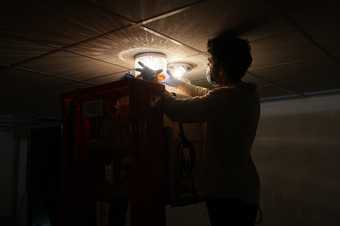
Fig.13
Figueiredo Silva installing the lamps on the ceiling, Tate Britain, 2021
Photo: Tate
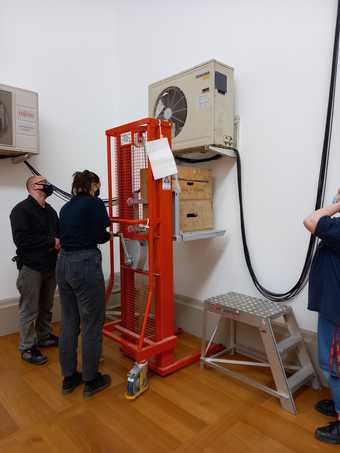
Fig.14
Dale Wilson, Senior Art Handler (left), and Emma Angold, Art Handler (middle), installing one of the air conditioning units, Tate Britain, 2021
Photo: Tate
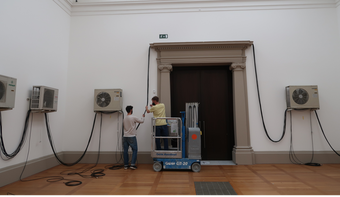
Fig.15
Morris (left) and the author (right) installing the air conditioning units, Tate Britain, 2021
Photo: Tate
In acquiring and displaying Okon’s works we had attempted to set out a timeline, informed by experience and museum processes. Put simply, we had planned an interview or two, followed by a test installation in which we hoped to learn about the work – enough that we could describe its permutations and its connections to a network of people within our documentation framework. We then hoped that we could refine this understanding through installing the work. What actually unfolded was of a different character: the interviews did not give us answers, but showed us that we needed a new way of learning. On reflection, throughout the installation process, information about the work fizzed and bubbled through multiple tiny interactions with the objects, the space, and the many people who came together to install the artwork (figs.11–13). Questions about the installation of the ceiling tiles were refined in dialogue with ceiling contractors, happy accidents by the electricians informed the way the cables draped, and the reluctance of some of the fans to spin as freely as others versed us in how to work with their differences (figs.14–15).
As mentioned, the test installation could not happen due to restrictions resulting from the COVID-19 pandemic, but it was also proving hard to pin down what such a test was actually for, since its success from a knowing, museum conservation perspective relied on being able to try out potential layouts, evaluate them, and develop a foundational, repeatable logic for future permutations. We since learned that to uncover the underlying themes of Okon’s work would take time, trust and an openness to change. Reflecting on this process, it seems striking how quantitative, almost reductive, our test terms are when applied to a work that expands and unfolds so much through interaction, relating and learning. It somehow had the same confining characteristics as an artist interview, only this time in the order of spaces and things.
Caring and loving
Throughout our research on Okon’s work I had a niggling anxiety that we were going to miss something, that there was a kind of loss that we did not yet have a name for. Secretly I had started to think of it as the magic in love – that in the research project, meetings, interviews and installation, there was fun, exploration, challenge and learning. There was an alchemy that would not be held by the museum’s memory. I am grateful that I was working with a team who encouraged me to call it what it is!
Having named the feeling as one of love, I set off in search of written affirmation. In the museum education scholar Emily Pringle’s essay ‘Art Practice, Learning and Love: Collaboration in Challenging Times in the Tate Learning Department’, she explores what it might mean to more boldly hold space for love in her work, citing words of encouragement from educational theorist Paulo Freire:
We must dare, in the full sense of the word, to speak of love without the fear of being called ridiculous, mawkish, or unscientific, if not antiscientific. We must dare in order to say scientifically, and not as mere blah-blah-blah, that we study, we learn, we teach, we know with our entire body. We do all of these things with feeling, with emotion, with wishes, with fear, with doubts, with passion, and also with critical reasoning. However, we never study, learn, teach, or know with the last only. We must dare so as never to dichotomize cognition and emotion.41
Pringle then interprets this for her work in Tate’s learning department: ‘Amongst other things, what I understood Freire to be saying here was that we need to bring an emotional and intellectual commitment to all that we do; that “love” represents the degree of engagement that we must make to our work to ensure it is of the highest quality.’42
Bolstered by this advocacy for emotional engagement, I wanted to explore how naming and recognising love and its differences from care might help cement it as something I could describe and advocate for. In some ways I was searching for a definition. Would that be possible? Is it helpful? Writer and activist bell hooks argues that care is a component of love, among other qualities: ‘To truly love we must learn to mix various ingredients – care, affection, recognition, respect, commitment, and trust, as well as honest and open communication.’ In this sense, love would sit well within museum life. Yet care, though often given with feeling, can be co-opted, or given out of a sense of duty, or professionalised and monetised. Perhaps the term ‘love’ describes a purity of ambition and attentiveness to the core feeling of the artwork – qualities that cannot be hidden among the neutral voice; that demand visibility and positionality; that might help to reveal voices in the conservation of unruly works. This chimes with a paper by the conservator Caroline Villers in which she discusses a shift away from impartiality or neutrality and places emphasis on ‘interpretative, negotiative and communicative aspects of conservation practice’, a ‘post minimal intervention’ that would
foreground interpretation, negotiation, and communication and would not hide behind the construction of conservation as impartial. It would involve letting go of some of the sustaining professional myths of conservation, and its grand narratives, such as preserving the work of art unchanged, the objectivity of scientific methodology, and the neutrality of intervention.43
Perhaps, then, operating with love can help us notice when our integrity is impacted by the pressures of timelines and workflows, and in this way showing love can be a form of resistance.
I am aware that in this exploration of love I have fallen into the final trap: I felt the pressure of needing to know it, to define it. While I cannot arrive at a singular definition of love, I can describe to you my unfolding story, and I can note the texture of how it sits within the museum. Learning the works by Okon has created an environment where we talked, shared and explored. I was worried that we would lose the magic and love of the artwork unfolding. From the perspective of caring and knowing, such loss feels bad, and tells us we are doing something wrong. But from the perspective of caring and loving, loss tells us that something happened, that the artwork lived. If the museum’s documentation does not hold the life of the work, then do its people hold it?
If the shift away from ‘caring and knowing’ towards ‘caring and loving’ is a better point from which to support the life of complex works within the museum – accepting love, life and loss – it raises the question: when the process of display happens again, how will the millions of fizzy contacts between all the people and the objects be remade? How will it be different? How will it feel for everyone involved?
Caring and adapting
Along with the fear of loss, I also felt the pressure of how to communicate forward the richness of my learning. Domínguez Rubio makes the point that unruly artworks have not truly lived unless they have created change in ‘the relations and practices wherein they are inserted’.44 In reflecting on this I keep coming back to the experience of witnessing a close colleague relating to Okon’s artwork as part of their involvement in the installation process. An art school graduate, practising artist and fan of Okon’s work, this individual’s engagement with the artist and artworks drew out all kinds of strands of information, interacting with the objects and provoking conversations that led to new ways of understanding or contemplating the works. One evening, as we were finishing our work on the installation for that day, a spontaneous comment triggered an amazing impromptu conversation between this colleague, myself and Okon about Marxist principles of labour; this discussion catalysed our understanding of how Okon arrived at the prices of the works, how she values her ongoing involvement with them after they are collected, and why certain contractors performing certain tasks are important to her. My colleague’s role is ostensibly a technical one, and so while their enthusiasm is welcomed in the workplace, the framework of conservation documentation does not provide a natural home for their story or the aspects of the works that their ideas brought to life. They are also neurodivergent, meaning that telling their story in the already restrictive medium of text in templates and forms is made harder still. If Okon’s artworks have highlighted the limitations of our workflows from the artworks’ perspective, then this experience has highlighted their limitations from the perspective of museum staff. The need for a more expansive, open form of documentation is echoed by Domínguez Rubio:
[M]eanings, practices, and classifications emerge and unfold as the contingent result of the interplay between the physical properties of artworks and the practices created to preserve and display them. What is needed, then, is to develop explanations that are able to capture this ‘material unfolding of culture’ as a bottom-up process that emerges through diverse configurations of people, meanings, practices, and materials.45
It follows, then, that Okon’s works have impacted and caused adaptation at Tate. Our museum interpretation was reframed by the artist, our contracts rewritten to accommodate a differing vision of ownership, our approach to artist interviews altered, and our documentation frameworks tested, pushed and expanded upon. We failed at some adaptations that the artworks asked of us: the very long artwork title is still cut short on our collection management system, and even shorter on the Tate website, which is also unable to display the superscript formatting used for the majority of the title. The adaptation that Tate has been able to make, if viewed from afar, may seem incremental, and when viewed alongside changes brought about by other artworks might seem cumulative, but they were synchronous with a more fundamental change in me: through my encounters with Okon’s artworks the very core of my approach to conservation practice has been shifted, creating a divergence between the museum’s inherited conservation ethics and my belief in the potential for a renewed landscape of conservation. This shift is shared by some of the close colleagues with whom I worked on the project, and I get the feeling we are left with a newly widened gap, wondering how we might progress. It is from here that I offer the following hopes.
With each artwork that we encounter at Tate, through acquisition, display or loan, I hope that we as conservators can learn the work to show care from the perspective of the network from which the artwork has come. Perhaps the question can shift from ‘How can we care for this artwork?’ to ‘How can our care be shaped by this artwork?’. Rather than being surprised that an artwork does not want to be known, we could approach the question as: ‘How do you want me to know the work?’. I hope we can exercise love by slowing down and noting the true character of how an artwork asks for our engagement, while being alert to the external pressures and internal tendencies that might steer us otherwise. I hope that we can use our position of stewardship to be responsive to the change that unruly artworks are asking of us: endlessly teasing and questioning the limits of the corresponding documentation, and in the process drawing in new voices and unheard perspectives on the unfolding stories. I hope that the responsibility to absorb and enact this change is held by the institution as well as the individual working within it. The stories, ever more complex, and all the more alive, might seem a little further from pared-back efficiency, but they might be a little closer to truth.
Maybe each artwork requires us to let in just enough of its world to change a little bit of ours.
